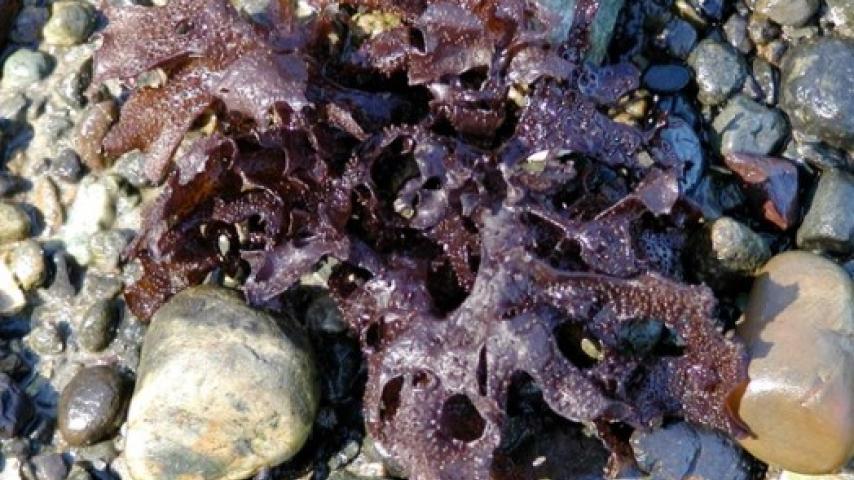Turkish Washcloth or Black Tar Spot (Mastocarpus papillatus)
Not really used by Turks as a washcloth, this species of red alga has a surface texture like such a cloth, at least in the female gametophyte.

KINGDOM Plantae - PHYLUM Rhodophyta - CLASS Florideophyceae - ORDER Gigartinales - FAMILY Phylloporaceae
Reddish-brown to blackish, it grows in abundance on rocky substrates in the high to mid intertidal zones of Pacific Northwest coastal waters. Male plants lack the papillae that dot the blades of the female and are paler in color. The alga is fairly small, the branched blade growing to about 15 cm in length.
The coloration of red algae is an adaptation to growing in deeper water, as their red pigment (phycoerythrin) involved in photosynthesis reflects red and absorbs blue wavelengths, which penetrate into deeper water. Mastocarpus has been found down to 250 meters. Phycoerythrin is used in the laboratory technique called immunofluorescence to determine, among other things, the presence and location of antibodies in tissue in the presence of fluorescent light.
Algae are fascinating to look at and often beautiful in their own way, but they don’t do much. What makes them especially interesting, however, is their complex reproductive cycle, and this one is more complex than most. Male gametophytes release nonflagellated sperm into the water column, and they are carried by the current to the female plants, where they lodge on receptive hairlike structures called trichogynes.
The attached sperm undergo mitosis without cell division, forming a spermatium. A fertilization pore between the spermatium and trichogyne allows fertilization. The fertilized eggs grow into a tetrasporophyte, which often looks just like the male and female gametophytes that produced it.
Under certain conditions, however, the fertilized gametes grow into a completely different sort of tetrasporophyte, a thin crust that looks like a patch of tar, thus the other common name. This is called the Petrocelis phase, from the name originally given to this stage, thought to be a very different type of alga. The tetrasporophyte produces tetrasporangia by meiosis, and the spores are released into the water column to germinate on another rock and complete the cycle. The encrusting stage at some point actually gives rise to the familiar branched plant.
Turkish Washcloth has been used extensively as a therapeutic food. It is much richer in vitamins than most land plants and is known to enhance the immune system, reduce bacterial infections, and suppress the growth of viruses, including herpes, HIV, and influenza.
We tend to think of organisms such as red algae as permanent fixtures in their ecosystem, but there is a fungal pathogen called red rot disease (Pythium porphyrae) that affects these plants and can wipe out extensive beds. It infests numerous kinds of red algae, and it has stimulated much research because of its effect on nori (Porphyra spp.), an important edible seaweed on the other side of the Pacific.